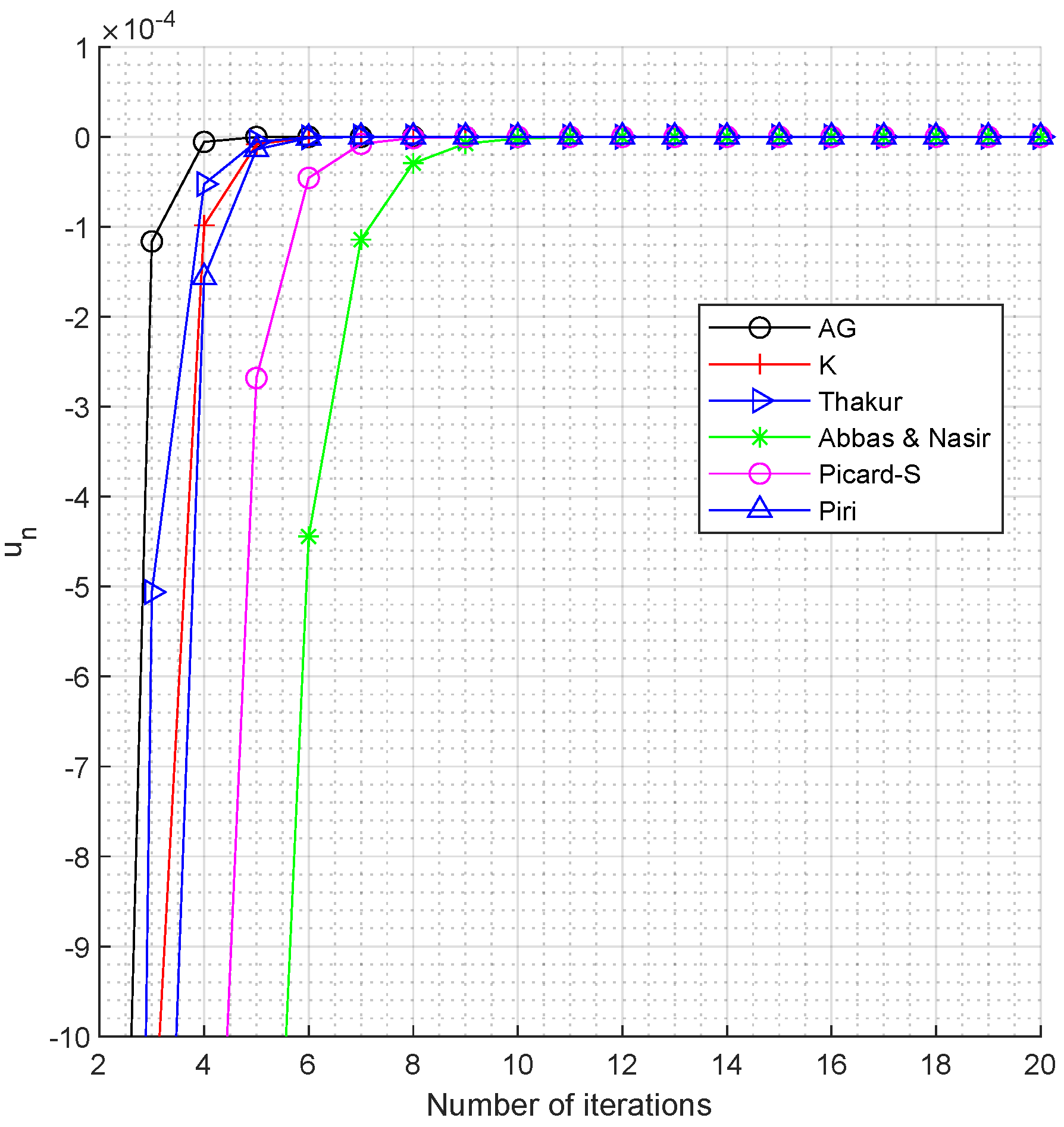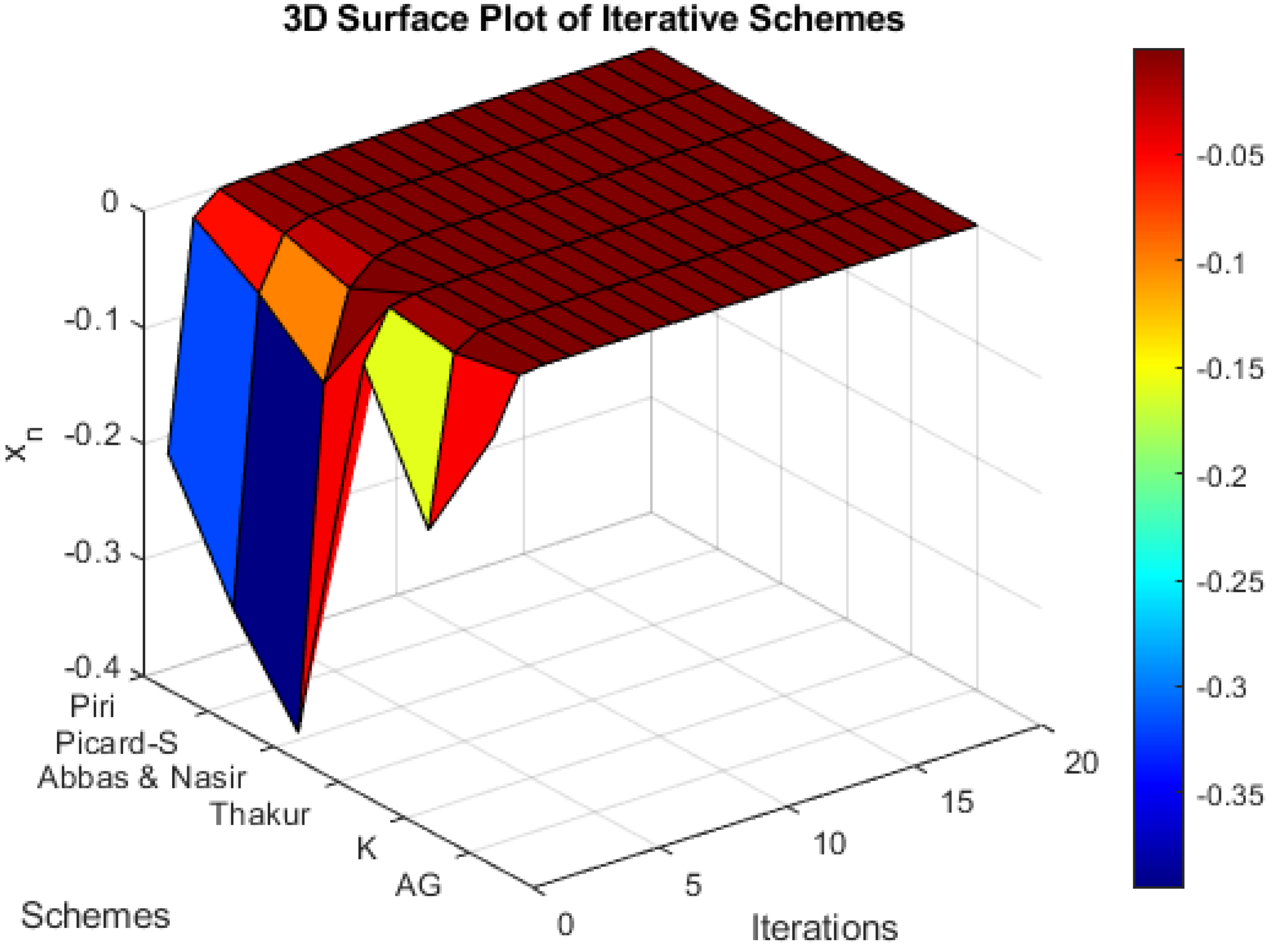Novel Method for Approximating Fixed Point of Generalized α-Nonexpansive Mappings with Applications to Dynamics of a HIV Model
Abstract
1. Introduction
2. Preliminaries
- (a)
- asymptotic radius of at u as a functional, defined by ,
- (b)
- asymptotic radius of relative to the set by
- (c)
- asymptotic center of relative to the set by
- is generalized α-nonexpansive whenever it satisfies condition .
- is quasi-nonexpansive whenever it is generalized α-nonexpansive.
- is closed in whenever is generalized α-nonexpansive.
- For each point , holds, whenever is generalized α-nonexpansive.
- If is generalized α-nonexpansive, a sequence in such that has Opial’s condition and is weakly convergent with weak limit ϖ, then whenever .
3. Main Results
Weak and Strong Convergence
4. Numerical Example and Rate of Convergence
5. Application to Mixed Type Integral Equation
- (C1)
- ;
- (C2)
- ;
- (C3)
- There exists nonnegative constants α, β, γ such thatfor all , ;
- (C4)
- There exist nonnegative constants and such thatfor all ;
- (C5)
- .
6. Application to the Spread of HIV Modeled as a Fractional Differential Equation of the Caputo Type
- (D1)
- There exists a constant such thatfor each and ,
- (D2)
- .Then (51) has a unique solution.
7. Conclusions
Author Contributions
Funding
Data Availability Statement
Conflicts of Interest
References
- Suzuki, T. Fixed point theorems and convergence theorems for some generalized nonexpansive mappings. J. Math. Appl. 2008, 340, 1088–1095. [Google Scholar] [CrossRef]
- García-Falset, J.; Llorens-Fuster, E.; Suzuki, T. Fixed point theory for a class of generalized nonexpansive mapping. J. Math. Anal. 2011, 375, 185–195. [Google Scholar] [CrossRef]
- Aoyama, K.; Kohsaka, F. Fixed point theorem for α-nonexpansive mapping in Banach spaces. Nonlinear Anal. 2011, 74, 4387–4391. [Google Scholar] [CrossRef]
- Ariza-Ruiz, D.; Linares, C.H.; Llorens-Fuster, E.; Moreno-Galvez, E. On α-nonexpansive mappings in Banach spaces. Carpathian J. Math. 2016, 32, 13–28. [Google Scholar] [CrossRef]
- Pant, R.; Shukla, R. Approximating fixed points of generalized α-nonexpansive mappings in Banach spaces. Numer. Funct. Anal. Optim. 2017, 38, 248–266. [Google Scholar] [CrossRef]
- Okeke, G.A.; Udo, A.V.; Rasulov, Z. A novel Picard-Ishikawa-Green’s iterative scheme for solving third order boundary value problems. Math. Meth. Appl. Sci. 2024, 47, 7255–7269. [Google Scholar] [CrossRef]
- Khuri, S.A.; Sayfy, A.; Zaveri, A. A new iteration method based on Green’s functions for the solution of PDEs. Int. J. Comput. Math. 2016, 3, 3091–3103. [Google Scholar] [CrossRef]
- Khuri, S.A.; Sayfy, A. Numerical solution of functional differential equations: A Green’s function-based iterative approach. Int. J. Comput. Math. 2018, 95, 1937–1949. [Google Scholar] [CrossRef]
- Khuri, S.A.; Louhichi, I. A new fixed point iteration method for nonlinear third-order BVPs. Int. J. Comput. Math. 2021, 98, 2220–2232. [Google Scholar] [CrossRef]
- Ali, F.; Ali, J.; Uddin, I. A novel approach for the solution of BVPs via Green’s function and fixed point iterative method. J. Appl. Math. Comput. 2020, 66, 167–181. [Google Scholar] [CrossRef]
- Alshehry, A.S.; Mukhtar, S.; Khan, H.S.; Shah, R. Fixed-point theory and numerical analysis of an epidemic model with fractional calculus: Exploring dynamical behavior. Open Phys. 2023, 21, 20230121. [Google Scholar] [CrossRef]
- Okeke, G.A.; Udo, A.V.; Alqahtani, R.T.; Hussain, N. A faster iterative scheme for solving nonlinear fractional differential equation of the Caputo type. AIMS Math. 2023, 8, 28488–28516. [Google Scholar] [CrossRef]
- Abbas, M.; Nazir, T. A new faster iteration process applied to constrained minimization and feasibility problems. Mat. Vesn. 2014, 66, 223–234. [Google Scholar]
- Gürsoy, P.; Karakaya, V. A Picard-S hybrid iteration method for solving a differential equation with retarded argument. arXiv 2014, arXiv:1403.2546v2. [Google Scholar]
- Thakur, B.S.; Thakur, D.; Postolache, M. A new iterative scheme for numerical reckoning fixed points of Suzuki’s generalized nonexpansive mappings. Appl. Math. Comput. 2016, 275, 147–155. [Google Scholar] [CrossRef]
- Hussain, N.; Ullah, K.; Arshad, M. Fixed point approximation of Suzuki generalized nonexpansive mappings via new faster iteration process. J. Nonlinear Convex Anal. 2018, 19, 1383–1393. [Google Scholar]
- Piri, H.; Daraby, B.; Rahrovi, S.; Ghasemi, M. Approximating fixed points of generalized α-nonexpansive mappings in Banach spaces by new faster iteration process. Numer. Algorithms 2018, 81, 1129–1148. [Google Scholar] [CrossRef]
- Ullah, K.; Ahmad, J.; Khan, B. Iterative approximations for generalized nonexpansive mappings using K iteration process in Banach spaces. Ser. Math. Inform. 2024, 39, 343–354. [Google Scholar] [CrossRef]
- Senter, H.F.; Dotson, W.G., Jr. Approximating fixed points of nonexpansive mappings. Proc. Amer. Math. Soc. 1974, 44, 375–380. [Google Scholar] [CrossRef]
- Goebel, K.; Kirk, W.A. Topics in Metric Fixed Theory; Cambridge University Press: Cambridge, UK, 1990. [Google Scholar] [CrossRef]
- Opial, Z. Weak convergence of the sequence of successive approximations for nonexpansive mapping. Bull. Amer. Math. Soc. 1967, 73, 591–597. [Google Scholar] [CrossRef]
- Agarwal, R.P.; O’Regan, D.; Sahu, D.R. Fixed Point Theory for Lipschitzian Type Mppings with Applications; Topological Fixed Point Theory and Its Applications; Springer: New York, NY, USA, 2009; Volume 6. [Google Scholar] [CrossRef]
- Schu, J. Weak and strong convergence to fixed points of asymptotically nonexpansive mappings. Bull. Austral. Math. Soc. 1991, 43, 153–159. [Google Scholar] [CrossRef]
- Hussain, A.; Baleanu, D.; Adeel, M. Existence of solution and stability for the fractional order novel coronavirus (nCoV-2019) model. Adv. Differ. Equ. 2020, 2020, 384. [Google Scholar] [CrossRef]


| Step | AG | K | Thakur | Abass–Nasir | Picard-S | Piri |
|---|---|---|---|---|---|---|
| 1 | −0.0485 | −0.1594 | −0.0469 | −0.3952 | −0.3187 | −0.2156 |
| 2 | −0.0023 | −0.0136 | −0.0049 | −0.1016 | −0.0543 | −0.0194 |
| 3 | −0.0001 | −0.0012 | −0.0005 | −0.0261 | −0.0092 | −0.0017 |
| 4 | 0.0000 | −0.0001 | −0.0001 | −0.0067 | −0.0016 | −0.0002 |
| 5 | 0.0000 | 0.0000 | 0.0000 | −0.0017 | −0.0003 | 0.0000 |
| 6 | 0.0000 | 0.0000 | 0.0000 | −0.0004 | 0.0000 | 0.0000 |
| 7 | 0.0000 | 0.0000 | 0.0000 | −0.0001 | 0.0000 | 0.0000 |
| 8 | 0.0000 | 0.0000 | 0.0000 | 0.0000 | 0.0000 | 0.0000 |
| 9 | 0.0000 | 0.0000 | 0.0000 | 0.0000 | 0.0000 | 0.0000 |
| 10 | 0.0000 | 0.0000 | 0.0000 | 0.0000 | 0.0000 | 0.0000 |
| 11 | 0.0000 | 0.0000 | 0.0000 | 0.0000 | 0.0000 | 0.0000 |
| 12 | 0.0000 | 0.0000 | 0.0000 | 0.0000 | 0.0000 | 0.0000 |
| 13 | 0.0000 | 0.0000 | 0.0000 | 0.0000 | 0.0000 | 0.0000 |
| 14 | 0.0000 | 0.0000 | 0.0000 | 0.0000 | 0.0000 | 0.0000 |
| 15 | 0.0000 | 0.0000 | 0.0000 | 0.0000 | 0.0000 | 0.0000 |
| 16 | 0.0000 | 0.0000 | 0.0000 | 0.0000 | 0.0000 | 0.0000 |
| 17 | 0.0000 | 0.0000 | 0.0000 | 0.0000 | 0.0000 | 0.0000 |
| 18 | 0.0000 | 0.0000 | 0.0000 | 0.0000 | 0.0000 | 0.0000 |
| 19 | 0.0000 | 0.0000 | 0.0000 | 0.0000 | 0.0000 | 0.0000 |
| 20 | 0.0000 | 0.0000 | 0.0000 | 0.0000 | 0.0000 | 0.0000 |
Disclaimer/Publisher’s Note: The statements, opinions and data contained in all publications are solely those of the individual author(s) and contributor(s) and not of MDPI and/or the editor(s). MDPI and/or the editor(s) disclaim responsibility for any injury to people or property resulting from any ideas, methods, instructions or products referred to in the content. |
© 2025 by the authors. Licensee MDPI, Basel, Switzerland. This article is an open access article distributed under the terms and conditions of the Creative Commons Attribution (CC BY) license (https://creativecommons.org/licenses/by/4.0/).
Share and Cite
Okeke, G.A.; Udo, A.V.; Alqahtani, R.T. Novel Method for Approximating Fixed Point of Generalized α-Nonexpansive Mappings with Applications to Dynamics of a HIV Model. Mathematics 2025, 13, 550. https://doi.org/10.3390/math13040550
Okeke GA, Udo AV, Alqahtani RT. Novel Method for Approximating Fixed Point of Generalized α-Nonexpansive Mappings with Applications to Dynamics of a HIV Model. Mathematics. 2025; 13(4):550. https://doi.org/10.3390/math13040550
Chicago/Turabian StyleOkeke, Godwin Amechi, Akanimo Victor Udo, and Rubayyi T. Alqahtani. 2025. "Novel Method for Approximating Fixed Point of Generalized α-Nonexpansive Mappings with Applications to Dynamics of a HIV Model" Mathematics 13, no. 4: 550. https://doi.org/10.3390/math13040550
APA StyleOkeke, G. A., Udo, A. V., & Alqahtani, R. T. (2025). Novel Method for Approximating Fixed Point of Generalized α-Nonexpansive Mappings with Applications to Dynamics of a HIV Model. Mathematics, 13(4), 550. https://doi.org/10.3390/math13040550






